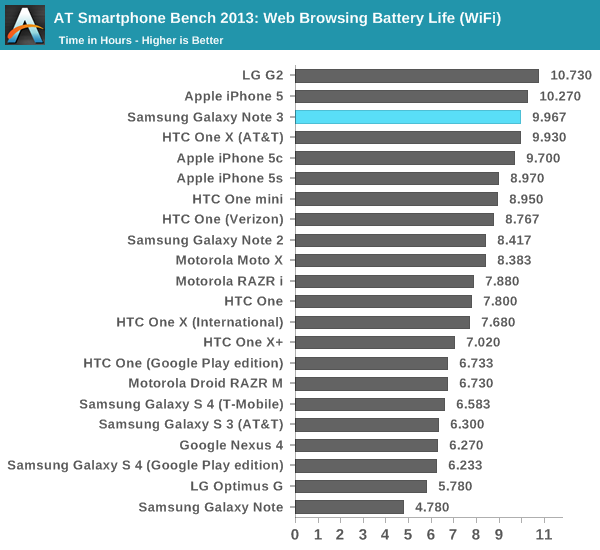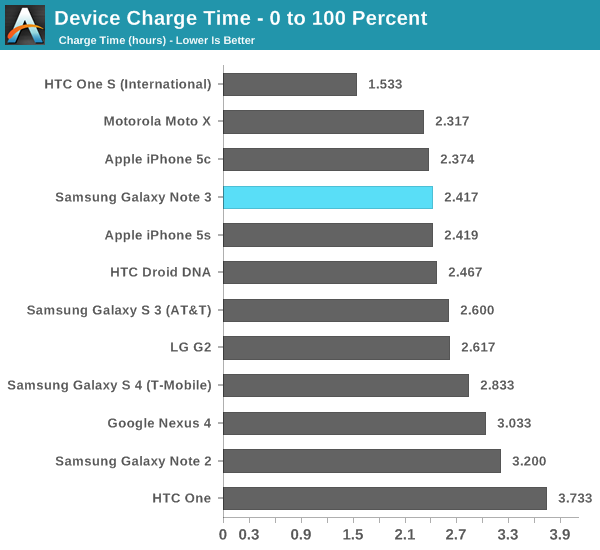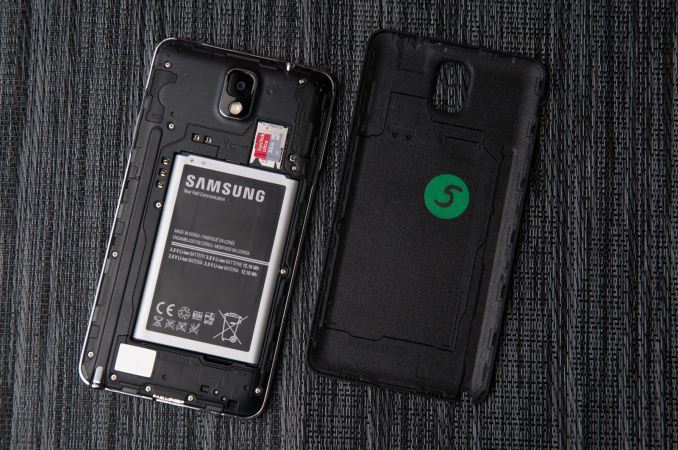Samsung Galaxy Note 3 Review
by Brian Klug on October 1, 2013 9:00 AM EST- Posted in
- Smartphones
- Samsung
- Mobile
- Android 4.3
- galaxy note 3
Battery Life
Battery life remains probably the single largest differentiator for devices lately, and of huge concern to enthusiasts and normal shoppers alike. We’ve already caught a glimpse of how well 8974 fares from a power perspective inside the LG G2, a device that posted some seriously impressive battery numbers. The Note 3 we’re looking at is also 8974 based since it’s a T-Mobile model, and thus we expect the same kind of battery life.
With this generation of Note, battery gets even larger. The Note started with a then quite large 9.25 watt hour battery, then Note 2 moved to 11.78 watt hours, and Note 3 now moves to a very large 12.16 watt hour battery with of course the newest 3.8V chemistry and all that comes along with it. Display size goes up, but those power gains are offset in other places.
After we talked about the panel self refresh features in the G2 a few people reached out and let me know that this feature has been shipping for a while in some phones, and it’s easy to check for. If we look under the display subsystem we can see that the same MIPI_CMD_PANEL type 9 is used, which refers to this type of interface.
Qualcomm HWC state: MDPVersion=500 DisplayPanel=9
define MIPI_CMD_PANEL ‘9’
Our battery life tests are unchanged and consist of a set of popular webpages that are loaded on a schedule with the display set to exactly 200 nits and repeated until the battery runs out and the device dies on both WiFi and cellular data connections. In this case that means T-Mobile LTE which is 10 MHz FDD in my market, I haven’t had a chance to run the Note 3 on HSPA+ yet, or complete the call test (which is starting to get ridiculous, and probably breaks 24 hours in the case of the Note 3).

On LTE the Note 3 does very well, coming just shy of the pack of iPhones, at just over 8 hours. Interestingly enough it’s just north of the G2s as well, which do have a smaller battery but also smaller display. The Note 3 also is the first device to ship with Qualcomm’s QFE1100 envelope tracker solution from the RF360 front end portfolio, which lowers power consumption by up to 20 percent and heat dissipation by up to 30 percent by allowing the power amplifiers to follow the desired output waveform. There’s more on that later in the cellular section.

On WiFi the Note 3 does better by 22 percent, but not the kind of huge jump I’m used to seeing between cellular and WiFi testing. This tells me the Note 3 battery life is really gated by the display, which is almost always the largest consumer of power in a device. That said the Note 3 does very well all things considered, especially in comparison to the APQ8064 (Fusion 3) phones which came before it, like SGS4. New silicon and new process inside MSM8974 definitely helps move battery life forward here with the race to sleep game.
Charging is an interesting story on the Note 3, but primarily because of what doesn’t change. The Note 3 continues to use Samsung’s tablet charging specification and charger, which has 2 amps of maximum output. The Note 3 draws 2 amps over a considerable amount of the charging curve, like other Samsung devices (in the linear part of the charge curve). USB 3.0 doesn’t change things up here quite yet with the new supported charge voltages that are coming eventually with the power delivery specification.

The Note 3 does charge faster overall compared to the SGS4 however thanks in part to the new PMIC (PM8941) which is part of the overall 8974 platform story.











302 Comments
View All Comments
kmmatney - Tuesday, October 1, 2013 - link
The 5s has iOS, and some of us simply prefer it over Android. I've used both and have both Jailbroken iOS devices and rooted Android devices. I prefer iOS for devices I use the most, like my phone. Although a larger screen is nice, I'm not sure it's enough to get me to buy it over a 5S. I still have another 3-4 weeks to decide before I can upgrade. SD card, the pen, and removable battery don't matter and I won't use them, so it's really just screen size vs iOS for me.dugbug - Wednesday, October 2, 2013 - link
Oh please. Apple more than deserves reviews, as do the new intel chips. As does Android. The intense interest around the A7 was that it gets that performance at significantly lower clock rates. It is a vastly better chip, and fits the smaller handheld where battery space is a premium.What, are you guys begging for more power supply reviews?
steven75 - Wednesday, October 2, 2013 - link
It can do everything except fit comfortably in your pocket while walking, sitting down, climbing stairs, etc. I wouldn't carry an iPad Mini around with me for the same reason.Spunjji - Tuesday, October 8, 2013 - link
As a Note 2 owner, I do all of those things with my phone in my jeans pocket. Regular fit. The Note phones are significantly smaller than the iPad Mini. Thus yur argument is invalid. Now if you'd said kneeling down...ddriver - Tuesday, October 1, 2013 - link
No test of black levels and contrast ratio? Whyananduser - Tuesday, October 1, 2013 - link
AMOLED provides the perfect black(I'm personally always impressed by it every time). Everyone knows that by now and perhaps Anandtech reckoned it's pointless providing a chart with no bar next to the Note3.ddriver - Tuesday, October 1, 2013 - link
White levels are good on the iphone - they are included in the review. Black levels are inferior on the iphone - no need to include those in the review...Not to mention once again not a single native and multi-threaded CPU bench compares the note 3 to the 5s, probably because it will reveal the note 3 significantly faster than the 5s, which won't sit well with the "myth" about its performance apple PR created and websites like anand helped reinforce.
Come on anand...
Anand Lal Shimpi - Tuesday, October 1, 2013 - link
We've never included black levels for AMOLED phones as you're not actually measuring anything. We also obviously can't do contrast ratio thanks to the whole division by zero thing.ddriver - Tuesday, October 1, 2013 - link
There are still ambient factors, screen material properties and whatnot, even on amoled the black is not a perfect black and therefore contrast won't be infinite.ddriver - Tuesday, October 1, 2013 - link
I mean, just because a "black pixel" on amoled devices is not emitting light, it still has its physical properties and still reflects light, I doubt there will be exactly ZERO photos coming out of a black amoled screen. So, contrast ratio and black levels are still determinable.